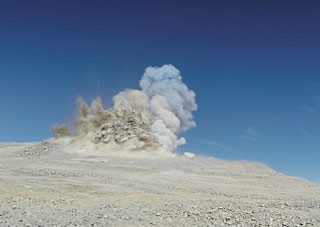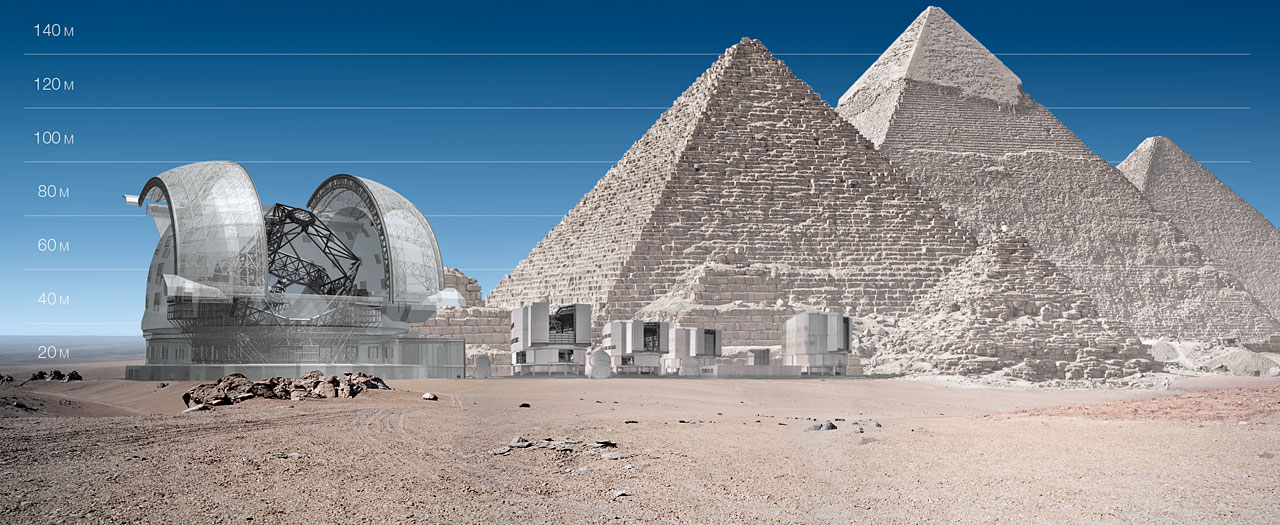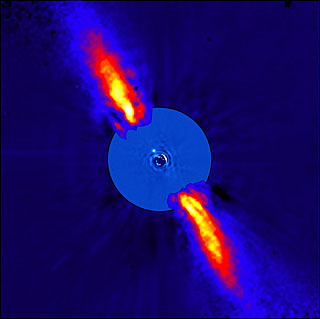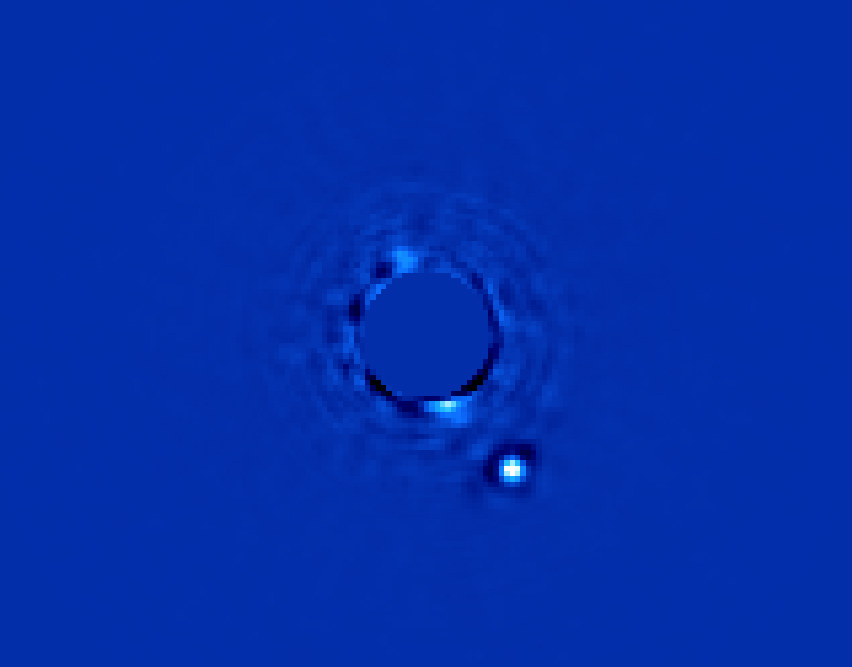Hardly ever a telescope will be built
1. Beginning.
On June 20, 2014, the top of Cerro Armazones was exploded - a mountain height of 3060 meters in the central part of the Atacama Desert in Chile. It was the first in a series of explosions aimed at removing 220,000 cubic meters of rock and creating a flat platform measuring 300x150 meters.

A platform will be built on the platform, which exceeds the size of everything that was before it - the largest telescope in the world.
The new generation of large (8-10 meters) astronomical instruments has brought many discoveries. We can assume that astronomy is now experiencing a golden era of its development. However, the projected European Extreme Large Telescope (E-ELT) will have opportunities that are an order of magnitude better than those of current telescopes. The “eye” of the telescope (the main mirror) will be almost 40 m in diameter (half of a football field) in diameter and will collect 15 times more light than the largest optical telescopes operating today. The main mirror is about 1000 sq.m. will be made up of almost 800 hexagonal segments of 1.4 meters in size, 50 mm thick.
')

Comparative dimensions of the future E-ELT, the already existing 10-meter Kekov (to the right of the E-ELT) and the Egyptian pyramids.
Against this background, all the other elements of the giant telescope design look like nothing: a secondary monolithic mirror with a diameter of 4.2 meters, although quite recently such a counter reflector would be nice to use as a primary mirror, and as many as five adaptive mirrors for correcting distortions introduced by the movement of air masses . Be that as it may, a project worth a billion euros is slowly but surely being implemented. If everything goes according to plan, in 2022 the Extremely Large Telescope will be ready and will see the “first light”.
2.Some assessment of opportunities.
What is expected from E-ELT?
First of all - the study of exoplanets. Not only the discovery of many planets, similar to the Earth, through indirect measurements, but also direct acquisition of images of large exoplanets, their satellites, characteristics of their atmospheres, observation of orbits. Solving the fundamental problems of the formation of planetary systems, the detection of water and organic molecules in protoplanetary disks around stars, the processes of origin and development of protoplanets. Great statistics for this are absolutely necessary. Today we know much more about stars than about planets, because we have the opportunity to observe so many different stars, but few different planets. Of the three thousand known earth-like exoplanets there will be less than a dozen.
In contrast to, for example, the Kepler space telescope, it will be possible to observe exoplanets, the orbital planes of which do not coincide with the line of sight, which means that they will be discovered much more. The 53 stars closest to the Sun in a sphere with a diameter of 10 parsecs are extremely interesting objects for the direct search for earth-like exoplanets. At least five of them are double with invisible satellites, and, therefore, with possible planets. Most likely, in twenty years, some evidence will be obtained of the existence of alien life - from the spectra of planetary atmospheres. Of course, if that exists on these planets.
The magnitude of the planet of the Jupiter type, removed by 1 AU. from a star like the Sun, when viewed from a distance of 10 parsecs, will be around 24. If one considers that an 8-meter telescope can see objects up to 27 stars, you can expect direct observation of exoplanets from E-ELT 30-31 zv.vel., Which is also very significantly increase their number.
Some of what is available at the moment, but soon there will be much more.
β Pictoris (Beta Painter) - a young star with a powerful protoplanetary disk, located in 63 of sv. years from us. Apparently, this planetary system is in the most active phase of formation.

And here is her exoplanet β Pictoris b (photo 2014, Gemini Observatory), discovered by direct observation. Now for this planet are regularly observed to accurately determine its orbit.

Planetary system HR 8799, opened by direct observation in the infrared. It is located at a distance of 129 over. years from Earth, in the constellation Pegasus.

The photo shows exoplanets b, c and d. Another planet e, like the star itself (which is always denoted by a), is covered by a special disk masking the light of the central star. Otherwise, the faint planets will drown in its light. The star HR 8799 is also young, only 60 million years old, all the exoplanets discovered are related to giant planets, have masses of about 10 masses of Jupiter and rotate at distances from 15 to 68 AU, which roughly corresponds to the situation with giant planets in the solar system. This system is interesting in that for the first time it was possible to observe the spectrum of the atmosphere of an exoplanet (HR 8799 c), and therefore determine the composition of this atmosphere.
In addition to exoplanets, on E-ELT one can see the disks of giant stars, close binary interacting stars, accretion disks in black holes. The theoretical resolution of E-ELT in visible light will be about 0.003 sec. The supergiant star Betelgeuse has a disk size of 0.055 sec. Here is her disk with a resolution of, say, 0.037 seconds, a field of view of about 0.5 seconds. The image was obtained by Very Large Telescope (8.2 m) using the adaptive NACO system and the “lucky imaging” technology.

As far as I understand, the side of this box is about 10-15 "points" (resolution elements). The new E-ELT telescope should improve the detailing several times. The difference in the image will be approximately, as at the Ultra HD TV in comparison with the standard definition TV.
Some scientists believe that Betelgeuse may soon have to explode as a type 2 supernova. It would be nice to watch such a landmark event in detail. And just to study its variability, a significant change in size and deviations from the spherical shape, well visible now. For some reason, its diameter over 15 years has decreased by 15 percent.
Alpha Centauri has an angular size of 0.006 sec. Alpha Centauri disk (about the size of the Sun) will be visible almost at the limit of resolution. By the way, at least one planet is there, and it will also be seen directly. Before observing the disks of the planets, of course, even such a giant telescope is not very strong. Exoplanet landscapes, which love to draw all who feel like it, will remain fantasy for a very long time.
There are other exciting issues for E-ELT. More accurate measurements of the dynamics of the expansion of the universe, possible changes in the fundamental physical constants over time. The more distant supernovae we see (the E-ELT sensitivity will be more by an order of magnitude than the VLT), the more precisely we will determine how Hubble’s “constant” is not constant, calculate the acceleration of the expansion of the Universe, understand something about dark energy and much more. Improved understanding of the evolution of the oldest objects that have formed in the universe: the primary stars, primary galaxies and black holes.
3. So it will work.

This is how E-ELT will work. Grand spectacle.
Laser beams form so-called “laser stars” in the upper atmosphere, the images of which are used to correct atmospheric distortions across the entire field of view of the telescope. Although the Extremely Large Telescope will be a construction of cyclopean sizes, the maximum deviation of the real surface of its mirror from its ideal shape should not exceed a few hundredths of a micron. The task is extremely difficult, and the problems are not limited to this. Here is some idea of the scale of the difficulties that the creators of the new telescope will have to overcome. For deformation and movement of each segment 15 electric motors are provided. On each segment there are 6 sensors that register its position relative to the neighboring segments. And if you consider that the segments are eight hundred, it turns out that you need to read data from almost 5 thousand sensors at speeds up to 1000 times per second. These are, apparently, elements of the so-called active optics, which retains the shape of mirrors during hovering and tracking. There will be more adaptive optics. At the same speed, it will be necessary to measure phase deviations and calculate control signals for 6,000 actuators - actuators, which should adaptively deform the surfaces of all five adaptive mirrors in real time. When observed, these mirrors will continuously and finely tremble with a kilohertz frequency, correcting turbulent phase distortions.
Opinion of the Director of the Special Astrophysical Observatory (SAO RAS), Corresponding Member of the RAS Y. Balegi.
Russia has been invited by the European Southern Observatory (ESO) to become a member of this organization and, in particular, to take part in the construction of the E-ELT. The introduction allows Russian astronomers to work on the largest ESO instruments that already exist - these are the VLT and the telescopes of the ALMA complex, as well as take part in the creation of the world's largest telescope, E-ELT. Our industry will be able to receive some orders for the manufacture of new systems, for example, 1000 segments of the E-ELT telescope's composite mirror. But the main thing is that our astrophysicists will be able to participate in solving the most important problems of natural science. Europe is interested in Russia, as the richest country in the world, supporting ESO with finances. No country in the world conducts avant-garde astrophysical research alone. The ALMA telescope complex on the Atacama Plateau in Chile was built with the participation of both Europe, the USA, Canada and Japan. The leading countries of the world understand that astrophysical research, as well as research in the field of nuclear physics, is an extremely expensive task for any country, and is solved only by the combined efforts of many countries. In the Ministry of Education and Science of Russia, it was thought that there was little money in the country, and we cannot join ESO for the reason that the Ministry of Finance will not find the means. But the entrance fee of 120 million euros the Europeans are ready to stretch for 10 years. The problem of joining ESO was discussed at a meeting of the Presidium of the Russian Academy of Sciences in 2011. All members of the Russian Academy of Sciences working in the field of astronomy, and these are about 20 people, have signed the corresponding document.
Now it is the end of 2014, no progress is observed. It is a pity that in the list of countries participating in the project of Russia is still not.
Sources
www.eso.org/public/teles-instr/e-elt.html - actually about a telescope, there are cool videos there)
www.eso.org/public/images/eso0927b - Betelgeuse
www.eso.org/public/images/eso0842a - beta Painter
www.gemini.edu/node/11150 - planetary system HR 8799
www.astronet.ru/db/msg/1263367 - interview with Yu.Balegi
Source: https://habr.com/ru/post/235507/
All Articles